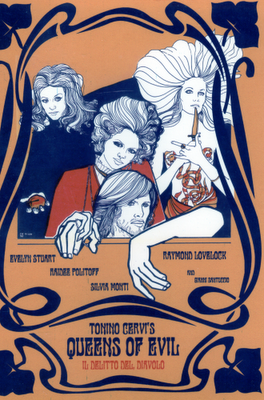 An Italian counterculture howler that will appeal to devotees of surreal baloney. It’s a colorful and flamboyant film to be sure, and even fairly enjoyable in its own loopy manner—which doesn’t change the fact that it’s complete nonsense in all other respects.
An Italian counterculture howler that will appeal to devotees of surreal baloney. It’s a colorful and flamboyant film to be sure, and even fairly enjoyable in its own loopy manner—which doesn’t change the fact that it’s complete nonsense in all other respects.
QUEENS OF EVIL (LE REGINE; IL DELITTO DEL DIAVOLO) was released in 1970, alongside other giallo-tinged counterculture oddities like DEATH LAID AN EGG (1968) and FEMMINE CARNIVORE (1970).
Notable participants in the film include its star Ray Lovelock, who previously headlined the infamous DJANGO KILL (1967) and went on to grace THE LIVING DEAD IN THE MANCHESTER MORGUE/LET SLEEPING CORPSES LIE (1974), AUTOPSY (1975) and TO BE TWENTY (1978).
Among his co-stars are Haydee Politoff, of the Eric Rohmer films THE COLLECTOR (1967) and CHLOE IN THE AFTERNOON (1972), and also COUNT DRACULA’S GREAT LOVE (1973); Silvia Monti, of A LIZARD IN A WOMAN’S SKIN (1971) and THE FIFTH CORD (1971); and Ida Galli, a.k.a. “Evelyn Stewart,” the film’s most seasoned performer, whose credits include LA DOLCE VITA (1960), HERCULES IN THE HAUNTED WORLD (1961), THE LEOPARD (1963), THE WHIP AND THE BODY (1963), THE PSYCHIC (1977) and many others.
The director Tonino Cervi (1929-2002) helmed the so-so spaghetti western TODAY WE KILL…TOMORROW WE DIE! (1968) and the nunsploitation classic THE NUN AND THE DEVIL (1973), but was better known as a producer, on the likes of BOCCACCIO 70 (1962), Bernardo Bertolucci’s THE GRIM REAPER (1962) and Michelangelo Antonioni’s RED DESERT (1964).
David, a young hippie on a motorcycle, happens upon a middle-aged man one night whose car has broken down. The man is quite snobby toward David, a member of an “impossible generation,” although he still leads him to a country house where, he promises, complete sexual satisfaction awaits—only to drop dead in his car before they reach the place. Continuing on, David finds the desired house, where he beds down for the night in an adjoining shed.
The next morning David is approached by a curly haired young woman who identifies herself as Liv. She tells him to leave, warning “they” might be upset at finding him on their property. “They” turn out to be a pair of attractive women, the brunette Biliana and the redhead Samantha, who encourage David to stay.
Inside the gaudily-decorated house David discusses his philosophy with the ladies, claiming “If I’m faithful to one woman it’ll mean I’m unfaithful to all the others.” Following a frolic in a nearby lake David and his companions approach an apparently enchanted castle, near which is an apple tree. Samantha offers an apple to David, who, apparently ignorant of the happenings in the Book of Genesis, eats it.
Later that day David is seduced by Samantha, and then the ladies inexplicably disappear. David searches the bizarre interior of their house and surrounding woods, where he happens upon the ladies standing around a fire, in preparation for a “Feast of the Nubile Maidens.” He’s seduced again, this time by Biliana.
David later spots the ladies talking with the apparently dead man he met on the road. David runs into the forest to confront the man, but gets caught in a freak storm. Following a riot of hallucinations David comes to the following morning to find the ladies attending to him. He asks about the man, and they claim he’s the owner of the nearby castle—where, it just so happens, he’s set to throw a party there.
David and the ladies head off to the party, which turns out to be stocked with a number of forbidding personages. These folk are identified as “those who count,” a.k.a. Society. David also gets seduced once again, this time by Liv. He’s now completely under the ladies’ spell, which turns out not to be such a good thing…
Director Tonino Cervi incorporates Greek mythology, Biblical themes and the Brothers Grimm into this film’s loopy panorama, together with the type of anti-conformist sentiment popular in the late 1960s. The film is unabashedly pro-counterculture, with the titular queens and narrow-minded old man seen at the beginning and end representing the evils of the straight world, which apparently wants nothing more than to prey on free-spirited young people like this film’s hippie protagonist. This aspect renders QUEENS OF EVIL unique, but not especially good.
The film’s problems start with the surprisingly traditional, workmanlike filmmaking, spiced with occasional late sixties flourishes (jump cuts, etc). The of-their-time hallucinations are plentiful but strictly medium-grade, accomplished through clichéd means such as distorted lenses and smoke (although the body paint seen on the ladies’ bodies in these scenes provides some memorable scenery). The sex scenes are likewise extremely plentiful, but none too arousing, with the participants’ nether regions “artfully” covered, and lots of close-ups of hands caressing legs
There’s also a ridiculously unsubtle, over-emphatic score that blatantly telegraphs any and every emotion, while the none-too-evocative art direction (evidently marred by the low budget) fails to evoke the dark fairy tale ambiance Cervi was trying to achieve. Nor is he helped by the poor English budding (subtitled Italian language prints exist, but the dubbed version is the most prevalent), leaving us with a film that despite its maker’s best efforts is ultimately very, very silly.
Vital Statistics
QUEENS OF EVIL (LE REGINE; IL DELITTO DEL DIAVOLO)
Carlton Film Export/Flavia Cinematografica/Labrador Films
Director: Tonino Cervi
Producer: Raoul Katz
Screenplay: Tonino Cervi, Raoul Katz, Antonio Troiso
Cinematography: Sergio D’Offizi
Editing: Mario Morra
Cast: Ray Lovelock, Haydee Politoff, Silvia Monti, Ida Galli, Gianni Santuccio, Guido Alberti, Geraldine Hooper
